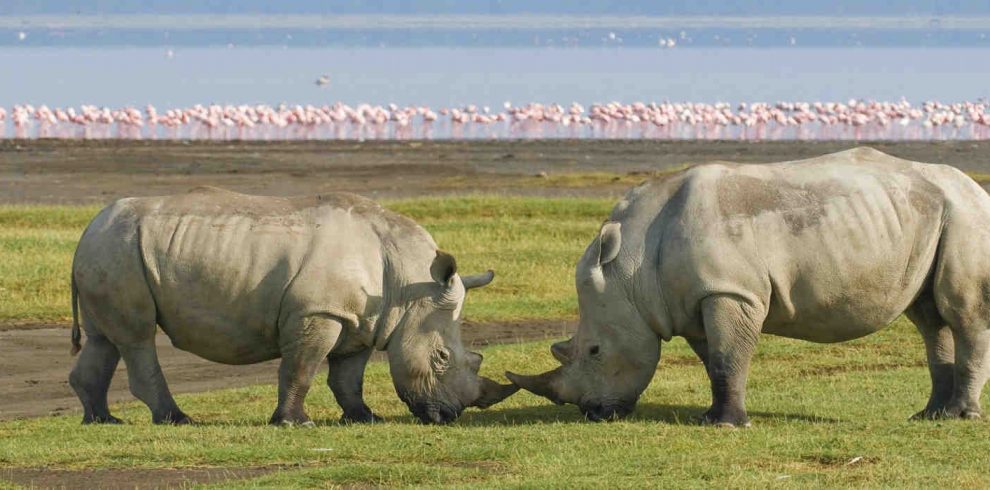Introduction

Lake Nakuru National Park : Surrounding the region of Lake Nakuru, this Park was established in 1961. It is mostly known for millions of flamingos that usually congregate along the shores of the Lake. Lake Nakuru is shallow and you can hardly recognize its surface due to the constant shifting mass of pink.
The number of these birds mostly depend on water and fish availability. Once they arrive at the shores, the view of the lake is one of the most spectacular sights that you can rarely find anywhere else.
About 27% of the Park’s area is occupied by the lake with crystal clear waters. With certainty, the best vintage point to see these converging flamingos is the Baboon cliff.
Moreover, about 550 varied plant species including the Euphorbia which are tall cactus-like trees add to the Park’s gentle and undulating terrain with open bush and woodlands.
The various animals found in the park
With the need to provide incredible habitats to the black Rhino, this park was enlarged and is now the best locality to go for these endangered species in Kenya. In 2009, reports indicted more than 25 species of black rhino in this Park and ranked the largest concentration in the country.
Lake Nakuru is home not only to the black rhino but also to the white rhino species. Other common wildlife species in Lake Nakuru include the Zebras, Rothschild’s giraffe, lion, leopard, and waterbuck.
If you are more interested in the reptiles, make sure to reach the dense woodlands for the large-sized pythons. You can see them crossing the road or dangling from tree branches.
Bird species
Then for birders, Lake Nakuru is for you. Leaving alone the flamingoes, this park play host over 300 species of birds. This region became Kenya’s first bird sanctuary in 1960. You have a lot to see during your excursions including the species of fish-eating birds.
Located 155km northwest of Nairobi and 5km from Nakuru town, this Park is easy to reach by road or air transport. By road, you can reach this area reached via a tar road from Nairobi. If not road, you can board a plane from Jomo Kenyatta International Airport just in the southeast of Nairobi.
Additionally, you can access Lake Nakuru National Park from several other parks. From Maasai Mara, the total distance is about 235km and takes about six hours for the drive.
From Samburu, the distance is 300km and expect to drive for about five and half hours. Then from Laikipia plateau the drive takes between three to seven hours depending on the reserve you are coming from.
Game drive
Game drive is one of the reasons for a trip to Lake Nakuru. It is offered in a well-conditioned vehicle with a pop-up roof and an expert guide to give detailed information about the Park’s natural wonders.
This option gives the chance to drive close to the Rhinoceros and as well a number of other Wild animals like warthogs, hippos, buffalo, Impala, Rothschild giraffes to name but a few.
Visit Makalia Falls.
Other than Wildlife, the Park has more to see and one of the must-sees is the Makalia falls. It is best to see this beautiful natural scenery during the rainy season when the water is in full flow.
The cascade makes for a spectacular sight. Adding to the scenic setting, the fall invites a number of Wildlife species. During the dry season, this fall is empty and it isn’t worth a visit.
Baboon cliff.
A trip to Lake Nakuru National Park isn’t it without visiting the Baboon cliff, the best vantage point in the area. In addition to the incredible views of the Park, this spectacular spot is home to baboons, one of the favorites for primate lovers.
Some baboons are friendly to visitors, but the larger males tend to be aggressive. You should therefore take care while in their presence.
Bird watching
When you talk about Lake Nakuru, the first thing to come into the travelers’ mind are the flamingos. This park is a great place to admire the fabulous water birds and other species.
From the baboon cliff, you will appreciate the beautiful view over the lake and a great spectacle of pink flamingoes.
To highlight more, the number of birds in the Park vary according to the availability of food. Therefore, endeavor to visit when there is plenty of food, birds will also be enough in numbers.







